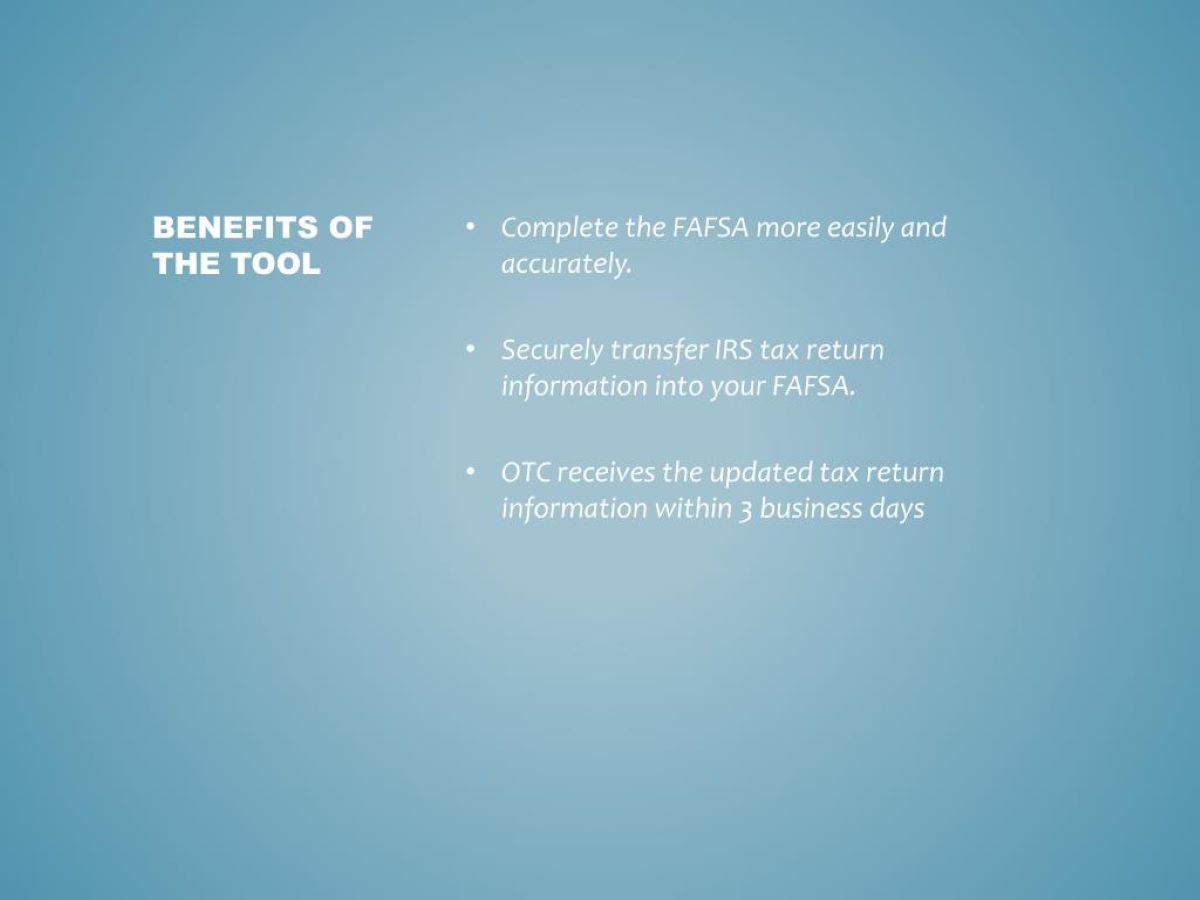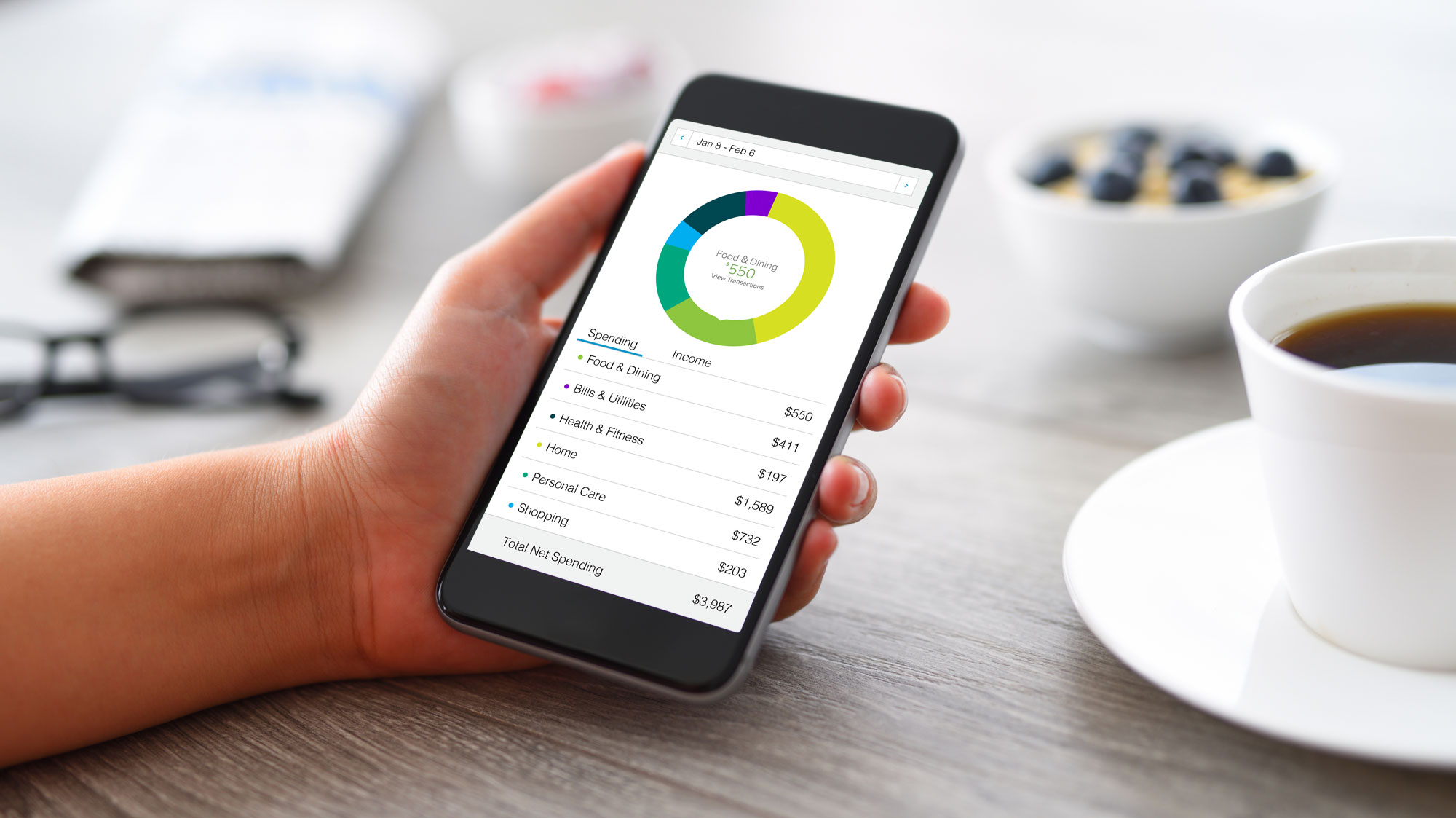Home>Finance>How To Use The IRS Data Retrieval Tool On FAFSA


Finance
How To Use The IRS Data Retrieval Tool On FAFSA
Modified: December 29, 2023
Learn how to use the IRS Data Retrieval Tool on FAFSA for your financial needs. Simplify your finance process and get accurate information.
(Many of the links in this article redirect to a specific reviewed product. Your purchase of these products through affiliate links helps to generate commission for LiveWell, at no extra cost. Learn more)
Table of Contents
- Introduction
- What is the IRS Data Retrieval Tool?
- Benefits of using the IRS Data Retrieval Tool on FAFSA
- Step-by-Step Guide to Using the IRS Data Retrieval Tool on FAFSA
- Preparing to Use the IRS Data Retrieval Tool
- Accessing the IRS Data Retrieval Tool on FAFSA
- Verifying Your Information on the IRS Data Retrieval Tool
- Submitting Your FAFSA with the IRS Data Retrieval Tool
- Common Issues and Troubleshooting While Using the IRS Data Retrieval Tool
- Important Tips and Reminders When Using the IRS Data Retrieval Tool
- Conclusion
Introduction
Welcome to the world of finance! Whether you are a seasoned investor or just starting out on your financial journey, understanding the intricacies of the financial world is crucial for achieving your goals. From managing personal finances to making wise investment decisions, having a solid understanding of finance is essential.
However, financial knowledge can sometimes be overwhelming, with complex terms and concepts that seem like a foreign language to many. That’s where we come in. As SEO experts with a deep understanding of finance, we are here to help guide you through the maze of financial information and provide you with comprehensive and engaging content that is optimized for search engines.
In this article, we will delve into the world of finance and provide you with valuable insights on a variety of topics, from budgeting and saving money to investing and retirement planning. We will break down complicated financial concepts into simple, easy-to-understand terms, ensuring that you can make informed decisions that align with your financial goals.
Our expertise in search engine optimization (SEO) ensures that the content we provide not only educates and informs, but also ranks well in search engine results. By incorporating relevant keywords and optimizing the structure of our articles, we can help your website gain visibility and attract a wider audience.
So, whether you are looking to build your financial knowledge or seeking assistance with SEO-optimized finance content, you’ve come to the right place. Let us be your trusted partner on your financial and digital journey, offering you valuable information and expert insights every step of the way.
What is the IRS Data Retrieval Tool?
The IRS Data Retrieval Tool is a convenient online tool that allows students and their families to automatically transfer their tax information from the Internal Revenue Service (IRS) directly onto their Free Application for Federal Student Aid (FAFSA). This tool simplifies the financial aid application process by eliminating the need for manual entry of tax data, reducing errors, and saving time.
The FAFSA is a critical document that students need to complete in order to determine their eligibility for federal student aid, such as grants, scholarships, and work-study programs. The form requires accurate financial information, including details from the previous year’s tax return. The IRS Data Retrieval Tool streamlines this process by allowing applicants to securely access their tax information and transfer it directly onto the FAFSA form.
By using the IRS Data Retrieval Tool, you can ensure that the information provided on your FAFSA is accurate and up-to-date, as it pulls the data directly from your tax return. This eliminates the risk of manual input errors and reduces the likelihood of your FAFSA being selected for verification, which can delay the processing of your financial aid application.
It’s important to note that not everyone is eligible to use the IRS Data Retrieval Tool. The tool is primarily designed for those who have already filed their federal tax return. If you have made any changes or corrections to your tax return post-filing, you may not be able to use the tool. Additionally, certain individuals, such as those who file an amended tax return or who are married and filed separately, may also be ineligible to use the tool.
Overall, the IRS Data Retrieval Tool is a valuable resource for students and families navigating the financial aid process. By simplifying the transfer of tax information, it helps ensure accuracy, saves time, and increases the chances of receiving the financial aid you need to pursue your educational goals.
Benefits of using the IRS Data Retrieval Tool on FAFSA
Using the IRS Data Retrieval Tool on the Free Application for Federal Student Aid (FAFSA) offers several key benefits for students and their families. Let’s explore some of the advantages:
1. Accuracy: By utilizing the IRS Data Retrieval Tool, you can ensure that the tax information provided on your FAFSA is accurate and matches the information on your tax return. This reduces the risk of errors and discrepancies, which can potentially affect your eligibility for financial aid.
2. Time-saving: Manually entering tax information onto the FAFSA form can be time-consuming and tedious. The IRS Data Retrieval Tool eliminates this hassle by automatically transferring the relevant tax data onto the form with just a few simple steps. This not only saves time but also reduces the likelihood of mistakes that can lead to delays in processing your application.
3. Simplified process: The FAFSA can be a complex document, especially when it comes to financial information. The IRS Data Retrieval Tool simplifies the process by eliminating the need to navigate through various tax forms and documents. Instead, you can directly access your tax information from the IRS database and transfer it onto the FAFSA, making the application process more straightforward and user-friendly.
4. Increased aid eligibility: The accurate transfer of tax information through the IRS Data Retrieval Tool can potentially increase your eligibility for financial aid. The tool ensures that you provide the most up-to-date and accurate financial information, which, in turn, helps determine your Expected Family Contribution (EFC). A lower EFC can translate into a higher eligibility for need-based grants, scholarships, and other forms of financial assistance.
5. Reduced chances of being selected for verification: The IRS Data Retrieval Tool helps minimize the chances of your FAFSA being selected for verification—a process where additional documentation is required to validate your financial information. By pulling information directly from your tax return, the tool provides a reliable source of data, reducing the likelihood of errors or discrepancies that could trigger a verification request.
6. Peace of mind: By using the IRS Data Retrieval Tool, you can have peace of mind knowing that your tax information is accurately transferred onto your FAFSA. This helps alleviate any concerns about providing incorrect or incomplete information, allowing you to focus on other aspects of the financial aid application process.
In summary, utilizing the IRS Data Retrieval Tool on the FAFSA offers numerous benefits, including increased accuracy, time savings, a simplified process, improved eligibility, reduced chances of verification, and peace of mind. This tool is a valuable resource for students and their families, streamlining the financial aid application process and increasing the likelihood of receiving the financial assistance needed to pursue higher education.
Step-by-Step Guide to Using the IRS Data Retrieval Tool on FAFSA
Using the IRS Data Retrieval Tool on the Free Application for Federal Student Aid (FAFSA) is a straightforward process that can save you time and ensure accuracy in reporting your tax information. Follow these steps to utilize the tool effectively:
Step 1: Start Your FAFSA: Begin your FAFSA application by visiting the official FAFSA website (fafsa.ed.gov) and selecting the appropriate year’s application. Create an account or log in using your FSA ID to access your existing application.
Step 2: Navigate to Financial Information: Once you’re logged in, locate the “Financial Information” section of the FAFSA. Here, you’ll be asked to provide details about your and your family’s income and assets. Look for the question that asks whether you have “already completed” or “will file” a tax return.
Step 3: Answer the Tax Return Question: Depending on whether you have already filed your tax return or will file later, select the appropriate response to the tax return question. If you have already filed, choose “Already Completed” and proceed to the next step. Otherwise, select “Will File” and manually enter your financial information for the time being, and return to the FAFSA later to update it once you have filed your taxes.
Step 4: Access the IRS Data Retrieval Tool: If you indicated that you have already filed your tax return, you will be given the option to use the IRS Data Retrieval Tool. Click on the link or button that says “Link to IRS.” This will redirect you to the IRS website.
Step 5: Authenticate Your Identity: On the IRS website, you will need to provide your federal tax filing status and other personal identifying information to verify your identity. Ensure that the information matches exactly what is on your tax return to avoid any issues.
Step 6: Transfer Your Tax Information: Once your identity is authenticated, you will be able to view your tax information from the IRS database. Review the information displayed and click the “Transfer My Tax Information Into the FAFSA” button. The relevant tax data will then be automatically entered into the appropriate fields on your FAFSA.
Step 7: Confirm and Submit: After transferring the tax information, review the populated fields on your FAFSA for accuracy. Make any necessary adjustments or additions as required. Once you are satisfied that the information is correct, continue with the remaining sections of the FAFSA, review your application one more time, and then press the “Submit” button.
Step 8: Finalize Your Submission: After submitting your FAFSA, you will receive a confirmation acknowledgment. If you have provided your email address, you will receive an email confirmation as well. Take note of any further steps or documentation required, and be sure to follow up accordingly.
Following this step-by-step guide will ensure a smooth and efficient process when using the IRS Data Retrieval Tool on the FAFSA. By leveraging this tool, you can save time and ensure the accuracy of your tax information, ultimately increasing your chances of receiving the financial aid you need to pursue your educational goals.
Preparing to Use the IRS Data Retrieval Tool
Before utilizing the IRS Data Retrieval Tool on the Free Application for Federal Student Aid (FAFSA), there are a few steps you can take to ensure a smooth and successful experience. By preparing in advance, you can streamline the process and avoid any potential roadblocks. Here are some essential tips for getting ready to use the IRS Data Retrieval Tool:
1. Gather Required Documents: Before starting your FAFSA, gather all the necessary documents you will need to complete the application. This includes your Social Security number, driver’s license, bank statements, business and investment records, and, most importantly, your tax information. Having these documents readily available will facilitate the process and prevent delays.
2. File Your Taxes Promptly: If you haven’t already done so, file your federal tax return as soon as possible. The IRS Data Retrieval Tool is designed for individuals who have already filed their taxes. Make sure your tax return is accurate and up-to-date to ensure that the information transferred to your FAFSA is correct.
3. Keep Copies of Your Tax Return: It’s always a good idea to keep copies of your filed tax return for your records. This will allow you to verify the accuracy of the information transferred through the IRS Data Retrieval Tool and serve as a reference in case any discrepancies arise during the application process.
4. Familiarize Yourself With Key Tax Information: Take the time to review and familiarize yourself with the tax information that will be transferred from your tax return to the FAFSA. This includes details such as adjusted gross income (AGI), total income earned, taxes paid, and untaxed income. Understanding these figures will enable you to spot any potential errors during the transfer process.
5. Ensure Accuracy of Personal Information: Double-check and ensure the accuracy of your personal information, such as your legal name, Social Security number, and date of birth. The IRS Data Retrieval Tool requires this information to match exactly with what is on your tax return to authenticate your identity and authorize the transfer of tax data.
6. Be Aware of Ineligible Tax Filing Situations: Although the IRS Data Retrieval Tool is widely applicable, there are certain situations in which it may not be available or usable. For example, if you have recently filed an amended tax return, filed taxes as “married filing separately,” or experienced a change in marital status after filing your tax return, you may not be able to use the tool. It’s important to be aware of these circumstances and be prepared to manually enter your tax information if necessary.
7. Keep Your FSA ID Ready: Your Federal Student Aid (FSA) ID is used to sign electronically on the FAFSA website. Make sure you have your FSA ID credentials ready before starting the FAFSA application. If you haven’t created one, visit the FSA website (studentaid.gov/fsa-id) and follow the instructions to establish your FSA ID.
By taking these preparatory steps, you can ensure a seamless experience when using the IRS Data Retrieval Tool on the FAFSA. Being organized, having accurate tax information, and understanding the tool’s limitations will help expedite the financial aid application process and increase the likelihood of accurate reporting.
Accessing the IRS Data Retrieval Tool on FAFSA
Accessing the IRS Data Retrieval Tool on the Free Application for Federal Student Aid (FAFSA) is a crucial step in seamlessly transferring your tax information onto the form. Follow these steps to effectively access the IRS Data Retrieval Tool:
Step 1: Start Your FAFSA: Begin by logging in to your FAFSA account at fafsa.ed.gov using your Federal Student Aid (FSA) ID. If you are a first-time user, you will need to create an FSA ID.
Step 2: Navigate to Financial Information: Once logged in, select the appropriate FAFSA year and proceed to the “Financial Information” section of the application. This is where you will provide details about your and your family’s income and assets.
Step 3: Indicate Tax Filing Status: Within the “Financial Information” section, you will come across a question regarding your tax filing status. Choose the appropriate response based on whether you have already filed your tax return or if you plan to file.
Step 4: IRS Data Retrieval Tool Option: If you have already filed your tax return, you will have the option to use the IRS Data Retrieval Tool. Select the “Link to IRS” button or equivalent option to access the tool. This will take you to the IRS website.
Step 5: Authenticate Your Identity: On the IRS website, you will need to verify your identity by providing personal identifying information. This includes your name, Social Security number, date of birth, and the filing status exactly as it appears on your tax return. Ensure the information is accurate to successfully authenticate your identity.
Step 6: Consent to Data Transfer: Once your identity is verified, you will be prompted to give consent for the IRS Data Retrieval Tool to transfer your tax information onto your FAFSA. Review the consent statement carefully and select the appropriate option to authorize the transfer.
Step 7: Return to the FAFSA: After consenting to the data transfer, you will be redirected back to the FAFSA website. You should see a confirmation message indicating that your tax information has been successfully transferred.
Step 8: Review and Verify: Review the transferred tax data on your FAFSA form to ensure its accuracy. Take note of any discrepancies or missing information and make the necessary corrections or additions manually. It is essential to ensure that all the transferred information matches your tax return precisely.
Step 9: Complete the FAFSA: After ensuring the accuracy of the transferred tax information, proceed to complete the remaining sections of the FAFSA, including providing information about assets, family size, and school choices. Review the entire form before submission.
Step 10: Submit Your FAFSA: Double-check all the information provided on your FAFSA and submit it electronically. You will receive a confirmation indicating that your FAFSA has been successfully submitted.
By following these steps, you will be able to access and utilize the IRS Data Retrieval Tool on the FAFSA effectively. Remember to verify the accuracy of the transferred tax information and complete the entire application before submitting. This will ensure a smooth and accurate financial aid application process.
Verifying Your Information on the IRS Data Retrieval Tool
After transferring your tax information using the IRS Data Retrieval Tool on the Free Application for Federal Student Aid (FAFSA), it’s crucial to verify the accuracy of the transferred data. Follow these steps to ensure that the information is correct:
Step 1: Review Transferred Information: Carefully review the tax information populated on your FAFSA form. Cross-reference it with your filed tax return to ensure that all the figures, including adjusted gross income (AGI), taxes paid, and untaxed income, match up accurately.
Step 2: Check Personal Information: Verify that your personal information, such as your name, Social Security number, and filing status, matches precisely with what is on your tax return. Any discrepancies in personal information could lead to issues with your financial aid application and delay the processing of your FAFSA.
Step 3: Compare with Supporting Documents: If you have supporting documentation related to your taxes, such as W-2 forms or 1099 statements, review those documents alongside your filed tax return to ensure consistency in the income figures. This can help identify any discrepancies or errors in the transferred information.
Step 4: Correcting Errors: If you notice any mistakes or inaccuracies in the transferred tax information, you have the option to correct them. The FAFSA provides a mechanism for manual data entry, allowing you to override the transferred information and enter the correct figures directly into the form. Make sure to double-check the accuracy of the corrected information before submitting.
Step 5: Seek Professional Assistance if Needed: If you are uncertain about the accuracy of the transferred tax information or need clarification on any tax-related matters, consider seeking assistance from a tax professional. They can review your tax return alongside the transferred information on the FAFSA and provide guidance or make necessary corrections if required.
Step 6: Document Your Verification Process: It is prudent to document the steps you took to verify the accuracy of the transferred tax information. This documentation can serve as proof of your due diligence and can be helpful if there are any questions or issues regarding your financial aid application.
Step 7: Maintain Records: Keep copies of your tax return, any supporting documents, and the verified FAFSA form for your records. These records will be useful if you need to refer back to them during the financial aid process or in case of an audit or verification request.
By diligently verifying the transferred tax information on the IRS Data Retrieval Tool, you can ensure that your FAFSA accurately reflects your financial situation. This attention to detail will help avoid processing delays, potential errors, and may increase your chances of receiving the financial aid you are eligible for.
Submitting Your FAFSA with the IRS Data Retrieval Tool
Once you have successfully utilized the IRS Data Retrieval Tool on the Free Application for Federal Student Aid (FAFSA) to transfer your tax information, it’s essential to complete the submission process accurately. Follow these steps to ensure a smooth and successful submission:
Step 1: Verify All Information: Before submitting your FAFSA, carefully review all the provided information, including the transferred tax data. Make sure it accurately represents your financial situation and matches the information on your tax return. Double-check personal details, income figures, and any other relevant information.
Step 2: Complete Remaining FAFSA Sections: After verifying the transferred tax information, proceed to complete the remaining sections of the FAFSA. This includes providing information about your household size, asset information, and school selections. Fill out each section accurately and thoroughly.
Step 3: Review for Errors: Take the time to review your entire FAFSA for any errors or omissions. Check for typos, missing information, or inconsistencies. Reviewing the form thoroughly can help avoid delays in processing and ensure accurate reporting.
Step 4: Seek Clarification if Needed: If you encounter any questions or uncertainties while completing your FAFSA, reach out to the FAFSA help center or consult with a financial aid professional. It’s important to have a clear understanding of the information you are providing to ensure accuracy.
Step 5: Provide Electronic Signature: As the final step before submission, sign your FAFSA electronically using your Federal Student Aid (FSA) ID. This serves as your legally binding signature and confirms that all the information provided is true and accurate to the best of your knowledge.
Step 6: Submit Your FAFSA: After signing your FAFSA, submit it electronically. You will receive a confirmation message indicating that your FAFSA has been successfully submitted. Additionally, you may receive a confirmation email for your records. Note any further steps or documentation required and be prepared to follow up accordingly.
Step 7: Maintain Copies of Documentation: It’s important to keep copies of your submitted FAFSA, along with any supporting documentation, for your records. This includes your tax return and any additional forms or statements provided. These documents may be requested for verification purposes or future reference.
Step 8: Monitor Application Status: After submitting your FAFSA, regularly check the status of your application to ensure that it is being processed smoothly. Stay informed about any further action required or additional information requested by the financial aid office. Be prepared to provide any requested documents promptly.
By carefully following these steps, you can ensure a successful submission of your FAFSA with the IRS Data Retrieval Tool. Submitting accurate and complete information will help expedite the processing of your financial aid application and increase your chances of receiving the assistance you need to pursue your educational goals.
Common Issues and Troubleshooting While Using the IRS Data Retrieval Tool
While the IRS Data Retrieval Tool on the Free Application for Federal Student Aid (FAFSA) generally streamlines the process of transferring tax information, there are some common issues that users may encounter. Being aware of these issues and knowing how to troubleshoot them can help ensure a smoother experience. Here are some common issues and their corresponding troubleshooting steps:
Issue 1: Ineligibility to Use the Tool: Not all individuals will be eligible to use the IRS Data Retrieval Tool. Reasons for ineligibility may include filing an amended tax return, selecting “married filing separately” as your tax filing status, or experiencing a recent change in marital status after filing your tax return. If you are ineligible, you will need to manually enter your tax information on the FAFSA.
Troubleshooting 1: If you are ineligible to use the IRS Data Retrieval Tool, carefully follow the FAFSA instructions for manually entering your tax information. Have your tax return and supporting documents readily available to ensure accuracy in reporting the information on the FAFSA.
Issue 2: Technical Difficulties: Occasionally, technical issues may arise during the process of accessing or using the IRS Data Retrieval Tool. This may include website downtime, slow loading speeds, or error messages.
Troubleshooting 2: If you encounter technical difficulties, try the following troubleshooting steps:
– Refresh the page and try again.
– Clear your browser cache and cookies before attempting to access the tool.
– Try accessing the tool during non-peak hours when website traffic is lower.
– If the problem persists, contact the FAFSA help center for further assistance.
Issue 3: Mismatched Personal Information: The personal information you provide on the FAFSA must match the information on your tax return exactly. Any discrepancies may result in errors or delays in processing your application.
Troubleshooting 3: To troubleshoot mismatched personal information:
– Double-check your tax return for accurate personal details.
– Ensure that your FAFSA reflects the same information as your tax return.
– If you notice any errors, manually correct them on the FAFSA before submitting.
Issue 4: Transferred Information Discrepancies: There may be instances where the transferred tax information on the FAFSA does not accurately reflect what is on your tax return. This can include discrepancies in income, deductions, or other tax-related data.
Troubleshooting 4: To address transferred information discrepancies:
– Review your tax return and supporting documents to identify the accurate information.
– If necessary, override the transferred information on the FAFSA with the correct figures.
– Ensure that any manual corrections are accurate and can be supported by your tax documentation.
Issue 5: Unavailable IRS Data: In some cases, the IRS Data Retrieval Tool may indicate that your tax information is not available for transfer due to certain circumstances, such as recently filing your taxes or making amendments.
Troubleshooting 5: In situations where the IRS data is unavailable, follow these steps:
– Manually enter your tax information on the FAFSA using your filed tax return as a reference.
– If you have not filed your taxes yet, estimate your tax information to the best of your ability and update it later once you have filed.
If you encounter any other issues or uncertainties while using the IRS Data Retrieval Tool, refer to the FAFSA help center or contact the financial aid office at your educational institution. Promptly addressing any issues can help ensure the accuracy and timely processing of your financial aid application.
Important Tips and Reminders When Using the IRS Data Retrieval Tool
Utilizing the IRS Data Retrieval Tool on the Free Application for Federal Student Aid (FAFSA) can greatly simplify the process of transferring tax information. To ensure a smooth and successful experience, keep the following tips and reminders in mind:
1. Maintain Tax Return Accuracy: File your tax return accurately and promptly before using the IRS Data Retrieval Tool on the FAFSA. Any errors or discrepancies in your tax information can lead to inaccuracies on your FAFSA and potential delays in processing your application.
2. Gather Required Documents: Collect all the necessary documents, such as your tax return and any supporting documentation, before beginning the FAFSA application. Having these documents readily available will facilitate the verification process and ensure accurate reporting of tax information.
3. Protect Your Personal Information: Safeguard your personal information when using the IRS Data Retrieval Tool. Ensure that you are accessing the tool on a secure and trusted website, and be cautious when entering personal identifying information to authenticate your identity.
4. Double-Check Transferred Information: After using the IRS Data Retrieval Tool, carefully review the tax information that has been transferred to your FAFSA. Verify that all figures, such as adjusted gross income (AGI) and taxes paid, accurately reflect your filed tax return. Make any necessary manual corrections if discrepancies are identified.
5. Keep Copies of Documentation: Retain copies of your filed tax return, any supporting documents, and a completed copy of your FAFSA. These documents may be requested for verification purposes or future reference. Keep them in a secure location, preferably in digital and physical formats.
6. Understand Tool Limitations: Be aware of the limitations of the IRS Data Retrieval Tool. Not all individuals may be eligible to use the tool, and certain situations, such as filing an amended tax return or selecting “married filing separately,” may make the tool unavailable. If you are ineligible, be prepared to manually enter your tax information on the FAFSA.
7. Follow Instructions Carefully: Pay close attention to the instructions provided on the FAFSA and the IRS Data Retrieval Tool. Follow the steps precisely to ensure a successful transfer of tax information. Any deviation from the instructions may result in errors or delays in processing.
8. Update your FAFSA if Necessary: If there are any changes to your tax information after using the IRS Data Retrieval Tool, such as filing an amended return or making corrections, promptly update your FAFSA to reflect the accurate information. Keeping your FAFSA updated is crucial for maintaining accuracy and eligibility for financial aid.
9. Seek Professional Assistance if Needed: If you encounter complex tax situations or have concerns about your tax information, seek guidance from a tax professional or financial aid advisor. They can provide personalized assistance and address any questions or uncertainties you may have.
10. Be Aware of Deadlines: Familiarize yourself with the FAFSA submission deadlines and any specific deadlines set by your educational institution for financial aid applications. Submitting your FAFSA with the IRS Data Retrieval Tool well before the deadlines will ensure timely processing and consideration for financial aid.
By keeping these important tips and reminders in mind, you can maximize the benefits of using the IRS Data Retrieval Tool on the FAFSA and increase your chances of receiving the financial aid you need to pursue your educational goals.
Conclusion
Understanding the complexities of finance is essential for making informed decisions and achieving your financial goals. As SEO experts with a deep understanding of finance, we have provided comprehensive and engaging content tailored to your needs. By incorporating search engine optimization techniques, we have optimized our content to increase visibility and attract a wider audience.
Throughout this article, we explored the IRS Data Retrieval Tool and its significance in simplifying the financial aid application process. We discussed the benefits of using the tool, provided a step-by-step guide on how to access and use it on the FAFSA, and offered troubleshooting tips for common issues.
We emphasized the importance of preparing for the use of the IRS Data Retrieval Tool by gathering required documents, filing taxes promptly, and verifying personal and tax information. Additionally, we highlighted the significance of verifying the transferred tax information for accuracy and the steps to take if errors are identified.
Furthermore, we emphasized the importance of being aware of tool limitations, understanding the process, and seeking professional assistance when needed. We also provided important reminders, such as protecting personal information and adhering to deadlines.
By following our tips and recommendations, you can streamline the financial aid application process and increase the likelihood of receiving the financial assistance needed to pursue your educational goals.
Remember, financial knowledge is a valuable asset that enables you to make well-informed decisions and navigate the complexities of the financial world. Whether you are managing personal finances, investing, or planning for your retirement, continuously expanding your financial knowledge is key.
As SEO experts, we are here to support you in your digital journey, providing informative and engaging finance content that is optimized for search engines. Feel free to explore our other articles and resources to further enhance your financial knowledge and stay up-to-date with the latest trends and insights in the finance industry.
Thank you for choosing us as your trusted partner in your financial and digital endeavors. We look forward to empowering you with the information you need to become financially savvy and achieve your financial aspirations.














